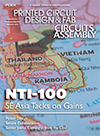News
News
Electronics Recycling in Korea
Published: 18 July 2007
by Junsik Yoon and Michael Kirschner
A national law governing electronics waste goes into effect Jan. 1.
Since 2001, five EU directives regarding the restriction of hazardous substances and the promotion of their recycling in the electrical and electronics products and automobiles have come into effect: WEEE, RoHS, EuP, Type Approval of Motor Vehicle and ELV. Regarding electrical and electronics products, RoHS restricts use of six hazardous substances in the products; EuP requires product design to consider environmental and energy attributes, and WEEE defines recovery and recycling of electric and electronics waste. For automobiles, ELV restricts four heavy metals in the products and prescribes the recovery and recycling of end-of-life vehicles; the revised directive for type approval contains newly added provisions for recyclability rate. These five EU directives are influencing other countries’ efforts, including Japan, China and the U.S., and the ripple effect is rapidly gaining.In the wake of the trend, since early 2003, Korea has considered a law corresponding to the EU regulations for electrical and electronics products and automobiles (Figure 1). It has now adopted the Act for Resource Recycling of Electrical/Electric Products and Automobiles, which includes all key regulatory actions of the five directives for those products. And it is drawing the attention of companies worldwide.
Click here to see Figures 1 and 2 (158 KB PDF file).
The key targets of these regulations are:
- Target products and restricted substances.
- Design for recyclability.
- Recycling information.
- End-of-life recycling system.
Detailed requirements in the final version of the Act and the draft version of the Enforcement Ordinance and Enforcement Regulation are:
1. Target products and restricted substances. Criteria for substance restriction, including type, maximum concentration values and exemptions will be consistent with the EU directives.
The final version of the Act says target products and restricted substances will be prescribed by presidential decree. The draft version of Enforcement Ordinance and Enforcement Regulation provides the details1:
Target products will be the same as the electrical/electronic products in the scope of a pre-existing Extended Producer Responsibility (EPR) regulation called “Act on the Promotion of Saving and Recycling of Resources”, which is now rolled into the Act. This includes 10 items: TVs, refrigerators, air conditioners, laundry machines, personal computers, audio devices, cellular phones, printers, copy machines and fax machines.
Restricted substances in electrical and electronic products are defined as lead, mercury, hexavalent chromium, cadmium, PBB and PBDE.
2. Design for recyclability. In case of the electrical and electronics products, due to the variety and complexity of products, the final version of the Act says producers and importers may comply with Technical Guidance on the Improvement of Materials and Structure. This guidance document describes recommendations for improving products reuse, recycling and recovery by focusing on such issues as material selection criteria, upgrades, and so on. Again, based on the draft, the requirement is2: As for automobiles, the recycling rate is clearly stipulated: 85% in 2009, 95% after 2010. For electrical/electronics product, there is currently no penalty for noncompliance, but the likelihood of such regulation is considerable.
3. Recycling information. Producers and importers shall provide recycling information and distribute it upon request to recyclers. Confidential information does not need to be provided.
The law is similar to the regulation for providing recycling information in the EU WEEE or ELV Directive. And as for automobiles, it states that, in accordance with the ELV Directive, in the event of distributing recycling information through an IDIS (International Dismantling Information System) the international car industry establishes and operates, the recycling information shall be deemed provided. Consequently, the law is likely to be constructed to minimize unnecessary efforts by the industry.
As requested from recyclers, manufacturers and importers shall provide recycling information such as product name, year of production, disassembly procedures, etc., through the Operation Management Information System or publicizing on their corporate Web site.
For recycling information, product name, year of production, disassembly procedure, composed materials, etc., should be provided.3
4. End-of-life recycling system (focusing on e-products). For electrical and electronic products, the 2003 EPR requirements are carried forward in the aforementioned law (Figure 2).
The trigger is extremely short for this law; the Enforcement Ordinance and Enforcement Regulation is expected to be finalized in October (followed rapidly by information concerning the detailed forms and delivery procedure), leaving only two months to prepare for the Jan. 1, 2008, effective date. If a company’s products fall within the scope of this regulation, we recommend the following immediate actions:
Review and understand the law and the draft Enforcement Ordinance and Enforcement Regulation (www.korearohs.com).
Review products sold in Korea; companies should already have established an EPR regimen and be compliant with the 2003 EPR law. Ensure these products are now compliant with EU RoHS, and further with Korea RoHS.
Ed.: Listen to The Aug. 14 Eco-Frontier/DCA Webinar, now available on demand, for a detailed review and discussion of this regulation (pcbshows.com/webinars/events/korearohs/ for more information).
Korea is becoming highly active in product-focused environmental regulation. Expect more regulations that impact the ability to market products there. Ensure methods are in place to keep up with these and other emerging regulations.
References
- Based on the draft Enforcement Ordinance and Enforcement Regulation of the Act for Resource Recycling of Electrical/Electric Products and Automobiles, May 2007.
- Ibid.
- Ibid.
Junsik Yoon is associate, SV2 team, Sustainability Value Division, at Eco-Frontier (ecofrontier.co.kr/eng/). Michael Kirschner is president of Design Chain Associates LLC (designchainassociates.com); mike@designchainassociates.com.
Press Releases
- Innominds and SIIX launch SIIX-Innominds JV to offer full-stack ODM services in India
- Syrma SGS Technology, Ltd to Accelerate AI-Driven Manufacturing with implementation of analytics and AI solution from Arch Systems in partnership with NMTronics India
- TTCI and The Training Connection Strengthen Electronics Manufacturing with Test Services and Training at PCB West 2025
- SMTA “Members of Distinction” Awards Announced







